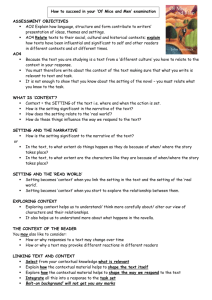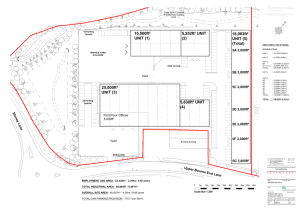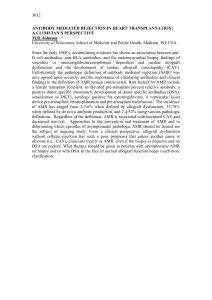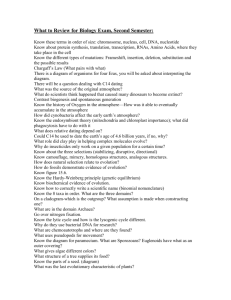Unit A663 - Student powerpoint
advertisement
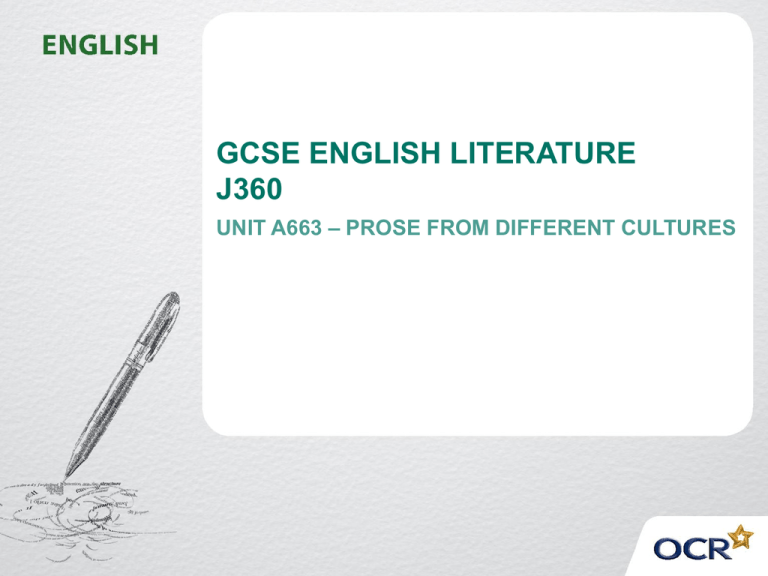
GCSE ENGLISH LITERATURE J360 UNIT A663 – PROSE FROM DIFFERENT CULTURES Preparing for the exam Know your text – you will not have time in the exam to keep referring to your clean copy of the text. Revise pre-taught material but be prepared to adapt it to focus on the question set. DO: structure your answer TASK Understand, respond, evaluate, personalise LANGUAGE TEXT Analyse the detail Consider context and overview A663 – Prose from Different Cultures There are TWO Assessment Objectives: AO2 Explain how language, structure and form contribute to writers’ presentation of ideas, themes and settings. You must incorporate comments on how the playwright uses language and structure to enhance/explore character, themes and ideas in the play. A663 – Prose from Different Cultures • AO4 Relate texts to their social, cultural and historical contexts; explain how texts have been influential and significant to self and other readers in different contexts and at different times. • You must explore the cultural setting of the text. How different readers may respond to the text over time, what the writer’s attitude is, and how the setting of the text influences the events and characters. Weightings of AO2 & AO4 AO4 has a higher weighting in the mark scheme than AO2. This means that you must make sure that you include many references to the cultural context of the text in your exam response. We are now going to consider how you can do this effectively. What is AO4? AO4: relate texts to their social, cultural and historical contexts; explain how texts have been influential and significant to self and to other readers in different contexts and at different times Practicalities • AO4 ‘quality’ is required, rather than just ‘coverage’ – examiners don’t want ‘bolted on’ information. • FOCUS and RELEVANCE are key – only include references to cultural context in your comments on the question set, as relevant to that question. • AS APPROPRIATE TO TEXT AND TASK • The key terms are ‘relate’ and ‘explain’ - not just ‘know about’. So what is ‘context’? ‘Context’ = exploring the SETTING of a text • How is the setting significant in the narrative of the text? • How does the setting relate to the ‘real world’? • How do these things influence the way we respond to the text? SETTING and THE NARRATIVE In the text, to what extent: • do things happen as they do • are characters like they are because of when/where the story takes place? Consider (eg): • Time / Period • Place • Culture / Community In a ‘different cultures’ text, any or all of these may be unfamiliar to the reader You couldn’t teach a Different Cultures text without addressing this unfamiliarity: the ‘context’. Setting and the ‘real world’ Setting becomes ‘context’: • when we link the setting in the text and a setting in the ‘real’ world • when we start to explore the relationship between them. To do this, we need some knowledge from outside the text: the social . . . cultural . . . historical . . . CONTEXT of the text Exploring setting How does exploring / understanding ‘context’: help us to understand make us think more carefully about alter our view of … etc the characters their relationships what happens ? …etc These are the areas A663 tasks will tackle. The context of the reader . . . explain how texts have been influential and significant to self and to other readers in different contexts and at different times For example • how/why a text may influence views/ attitudes/ circumstances • how/why responses to a text may change over time • how/why a text may provoke different reactions in different readers Any relevant response to these aspects WILL be credited If there is no reference to these aspects, the whole mark range will still be accessible – for example, they may not have been relevant to the extract or question set Linking text and context You need to learn how to: • select from your contextual knowledge what is relevant • explain how the contextual material helps to shape the text itself • explore how the contextual material helps to shape the way we respond to the text • integrate all this into a response to the task set ‘Bolt-on background’ is not what examiners are looking for. Never begin with an introduction about the cultural context of the text – your understanding of this element must be fully integrated into your response. THE TASK AO4 in the questions The Texts The specification prescribes the TEXT to be studied: •a prose text ‘from Different Cultures’ •so, by definition, setting and ‘context’ will be significant •and any reading / teaching / study can’t help but address these aspects AO4 Preparation (ii) The Exam Board does NOT prescribe the ‘CONTEXT’ to be studied. Your teacher will guide you to relevant ‘context’ as it arises in the novel. So, as events happen, you will learn about how the cultural context of the text has determined or influenced the events and characters. AO4 Preparation (iii) So, for example in Of Mice and Men, the specification does not prescribe: • the Great Depression of the 1930s • the ‘American Dream’ • the experience of black Americans BUT Any / all of these might be helpful – if used constructively. • …etc Ask - at key points, what ‘context’ will help to ‘open up’ the text to the reader ? . . . if it helps when reading, it should help when answering an exam question Exam Questions – the P T R structure A663 questions will: • PROMPT an exploration • of a specific TOPIC or issue in the text • and of a way of RESPONDING to this P T R So – generically - PROMPT What makes (F) How does the writer make (H) TOPIC [something in the text] RESPONSE so [adjective]? N.B. – there will also be: • a reminder about AO2 – ‘LANGUAGE’ etc. TASKS – an example of P T R The task asks the candidate: What makes the ENDING of the novel so POWERFUL and MOVING? The candidate asks him/herself: How does my KNOWLEDGE / UNDERSTANDING OF ‘CONTEXT’ help me to explain what makes the ENDING of this novel so POWERFUL and MOVING? The task also reminds the candidate about ‘language’ - eg at F tier: You should consider . . . • the words and phrases [the writer] uses P T R PROMPTS FOUNDATION TIER HIGHER TIER What makes . . . What are your feelings about . . . What are your impressions of . . What do you think . . . What do you find . . . How does [ ] bring home to you How does [writer] . . . How does X’s writing . . . Explore the ways [writer] . . . Explore the ways X’s writing . . . Explore how [writer] makes . . . In what ways does [writer] . . . P T R TOPICS and RESPONSES TOPICS RESPONSES FOUNDATION / HIGHER • • • • • the ending of the novel the way [character] is treated how the relationship changes what to admire / pity the harshness of everyday life FOUNDATION / HIGHER • • • • • powerful moving tense and exciting entertaining horrifying A Summary of the Importance of AO4 • You couldn’t learn a Different Cultures text without addressing . . . the ‘context’ • What ‘context’ will help to ‘open up’ the text to the reader? • AO4 performance will directly affect outcomes • Key terms are ‘relate’ and ‘explain’ - not just ‘know about’ • ‘Bolt-on background’ will not gain credit A Summary of the Importance of AO4 • DON’T underestimate - AO4 has teeth • DON’T overload - a little AO4 can go a long way • DO ask - how does ‘context’ help understanding / affect response ? • DO emphasise - keep it relevant to the task Some Simple Examples from “Of Mice and Men” • pp6–8: Lennie and his pockets: what we learn about him and his relationship with George. • pp23–25: the boss’s reaction to them. • pp56–58: livin off the fatta the lan’. • pp75–77: the truth about Crooks. • pp86–88: Curley’s wife and her dreams Over to you Find some more examples which put a moment/ character/ conversation in the novel first and the context second. Passage-based Questions There are two common problems: 1. Lack of focus on the passage 2. Lack of focus on the question AVOID: • An introduction about the author, historical or cultural setting/background. • Excessive detail when putting the passage in the context of the rest of the novel. • Detailed reference to the rest of novel outside the passage. Passage-based questions continued.... DO: • Read the question carefully and focus on the key words – highlight them. • Quote briefly and frequently from the passage to support your points. • Refer briefly to other points in the novel, tethering your comments firmly to the passage. • Think carefully about your point – don’t just include pretaught points unless you have made them relevant to your response. General/Discursive Essay • Make sure that you have understood the demands of the title. • Choose the sections of the novel that you look at carefully, ensuring that they are the most relevant moments. • Include brief, frequent quotations to keep your answer firmly rooted in the text. • Make sure that references to cultural context are fully integrated into your comments, not bolted on.

